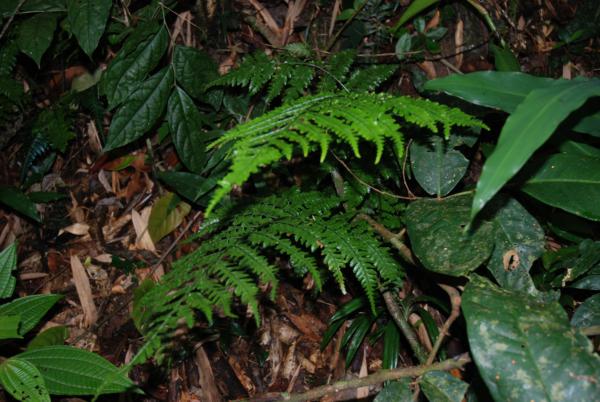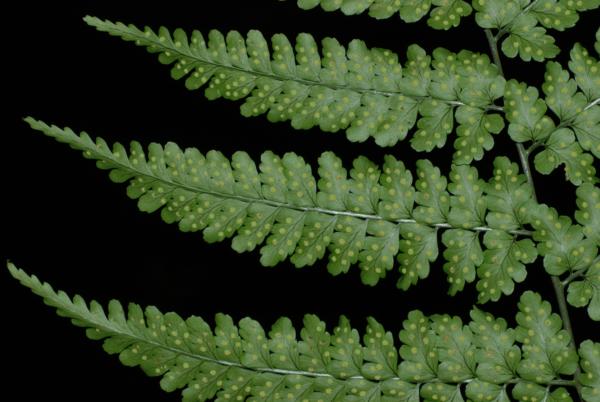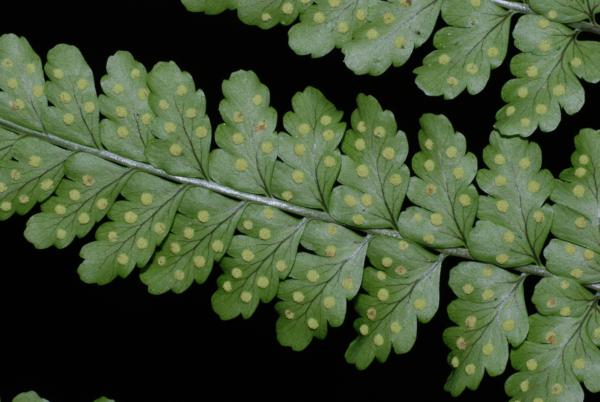
Dryopteris hasseltii (Blume) C.Chr.
Family
Dryopteridaceae
Nomenclature
Dryopteris hasseltii (Blume) C.Chr., Index Filic. 269. 1905. – Polypodium hasseltii Blume, Fl. Javae Fil.: 195, t. 92. 1828. – Rumohra hasseltii (Blume) Ching, Sinensia 5: 61. 1934; Tardieu & C.Chr., Fl. Indo-Chine 7(2): 328. 1941. – Polystichopsis hasseltii (Blume) Holttum, Rev. Fl. Malaya ed. 1, 2: 487, f. 288. 1955 [‘1954’]. – Arachniodes hasseltii (Blume) Ching, Acta Bot. Sin. 10: 258. 1962; Tagawa & K.Iwats., Acta Phytotax. Geobot. 24: 62. 1969; Tagawa & K.Iwats., Fl. Thailand 3: 340. 1988; Boonkerd & Pollawatn, Pterid. Thailand: 199. 2000. – Acrorumohra hasseltii (Blume) Ching, Acta Phytotax. Sin. 9: 385. 1964; Shieh et al., Fl. Taiwan ed. 2, 1: 307. 1994.
Nephrodium obovatum Baker, J. Bot. 1890: 265. 1890. – Lastrea obovata (Baker) Bedd., Suppl. Ferns Brit. Ind.: 60. 1892.
Phegopteris laserpitiifolia Scort. ex Bedd., Suppl. Ferns Brit. Ind.: 84. 1892.
Description
Terrestrial. Rhizome short, suberect, scaly; scales subtriangular, gradually narrowing from base towards hair-pointed apex, about 12 by 2.3 mm, brown or darker, entire. Stipes about 30 cm long, stramineous or darker at scaly base, glabrescent upwards. Laminae oblong-subdeltoid, acuminate at apex, about 40 by 25 cm, tripinnate; rachis stramineous, grooved above, glabrescent; all pinnae anadromous; basal pinna largest, stalked, unequally subtriangular with larger basiscopic basal pinnules, about 12 by 6 cm; upper pinnae ascending, narrowly oblong with long-acuminate apex; costa stramineous, grooved above, very narrowly winged; larger pinnule shortly stalked, oblong to ovate, rounded at apex, cordate at base, or subdimidiate to narrowly cuneate at basiscopic base; secondary pinnule sessile, oblong, rounded at apex, round or cuneate at base, lobed with two to four lobes at each side, often with a small acute lobe on the distal margin of the larger rounded lobes; ultimate lobes obliquely subdeltoid, acute at apex; herbaceous, veins distinct below, glabrous. Sori round, terminal on veinlets, medial or closer to midribs, up to 1.2 mm diam., naked.
Distribution in Thailand
NORTH-EASTERN: Loei; PENINSULAR: Nakhon Si Thammarat
Wider Distribution
NE India, N Vietnam, Hainan, Taiwan, Ryukyus, and throughout Malesia to New Guinea.
Ecology
In hill evergreen forest, often along streamlets, at 850–1350 m alt.
Proposed IUCN Conservation Assessment
Least Concern (LC). This species is fairly widespread and not under any known threats in Thailand (but see IUCN redlisting below).
IUCN Conservation Assessment
Endangered (EN A2c) as listed on the IUCN Red List at http://www.iucnredlist.org/apps/redlist/details/46609/0 under Acrorumohra hasseltii (Blume) Ching.
Voucher specimens - Thailand
Middleton et al. 4410, Nakhon Si Thammarat, Namtok Yong National Park (E).
Lower surface of frond
Sori
Site hosted by the Royal Botanic Garden Edinburgh. Content managed by Stuart Lindsay, Gardens by the Bay, Singapore and David Middleton, Singapore Botanic Gardens. Last updated 24 January 2012


